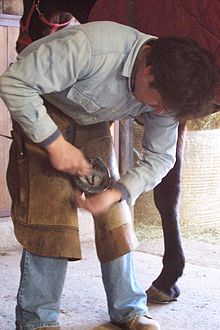| Revision as of 11:30, 11 May 2013 edit86.27.105.131 (talk) →Work← Previous edit | Revision as of 11:30, 11 May 2013 edit undoStephenb (talk | contribs)Extended confirmed users, Pending changes reviewers, Rollbackers54,745 edits Reverted 1 edit by 86.27.105.131 (talk). (TW)Next edit → | ||
| Line 19: | Line 19: | ||
| As a service based industry, farriers must combine technical competence with horsemanship and the ability to deal with clients. Self-employed farriers and those in partnerships may also require skill in running a small business. | As a service based industry, farriers must combine technical competence with horsemanship and the ability to deal with clients. Self-employed farriers and those in partnerships may also require skill in running a small business. | ||
| --] (]) 11:30, 11 May 2013 (UTC)farriers are very important--] (]) 11:30, 11 May 2013 (UTC) | |||
| ==Qualifications== | ==Qualifications== | ||
Revision as of 11:30, 11 May 2013
| This article needs additional citations for verification. Please help improve this article by adding citations to reliable sources. Unsourced material may be challenged and removed. Find sources: "Farrier" – news · newspapers · books · scholar · JSTOR (October 2009) (Learn how and when to remove this message) |



A farrier is a specialist in equine hoof care, including the trimming and balancing of horses' hooves and the placing of shoes on their hooves, if necessary. A farrier combines some blacksmith's skills (fabricating, adapting, and adjusting metal shoes) with some veterinarian's skills (knowledge of the anatomy and physiology of the lower limb) to care for horses' feet.
History and ceremonial
Historically, the jobs of farrier and blacksmith were practically synonymous, shown by the etymology of the word: farrier comes from Middle French: ferrier (blacksmith), from the Latin word ferrum (iron). A farrier's work in colonial America or pre-Industrial Revolution Europe would have included horseshoeing, as well as the fabrication and repair of tools, the forging of architectural pieces, etc. Modern day farriers usually specialize in horseshoeing, focusing their time and effort on the care of the horse's hoof. For this reason, farriers and blacksmiths are considered to be in separate, albeit related, trades.
In the British Army, the Household Cavalry have farriers who march in parade in ceremonial dress, carrying their historical axes with spikes. They are a familiar sight at the annual Trooping the Colour. There is also a farrier on call "round the clock, twenty-four hours a day, at Hyde Park Barracks."
In the United Kingdom, the Worshipful Company of Farriers is one of the Livery Companies of the City of London. The Farriers, or horseshoe makers, organised in 1356. It received a Royal Charter of incorporation in 1674. Over the years, the Company has evolved from a trade association for horseshoe makers into an organisation for those devoted to equine welfare, including veterinary surgeons.
Work
A farrier's routine work is primarily hoof trimming and shoeing. In ordinary cases, it is important to trim each hoof so it retains its proper orientation to the ground. If the animal has a heavy work load, works on abrasive footing, needs additional traction, or has pathological changes in the hoof, then shoes may be required.
Additional tasks for the farrier include dealing with injured or diseased hooves and application of special shoes for racing, training or "cosmetic" purposes. Horses with certain diseases or injuries may need remedial procedures for their hooves, or need special shoes.
As a service based industry, farriers must combine technical competence with horsemanship and the ability to deal with clients. Self-employed farriers and those in partnerships may also require skill in running a small business.
Qualifications
In the United Kingdom, it is illegal for people other than registered farriers to call themselves a farrier or to carry out any farriery work under the Farriers (Registration) Act 1975. The primary aim of the Act is to "prevent and avoid suffering by and cruelty to horses arising from the shoeing of horses by unskilled persons".
In the United States, however, farriery is not regulated, no legal certification exists, and consumers must inform themselves of a farrier's qualifications. Three organizations, the American Farrier's Association (AFA), the Guild of Professional Farriers (GPF), and the Brotherhood of Working Farriers (BWFA) maintain voluntary certification programs for U.S. farriers. Of these, the AFA's program is the largest with approximately 2800 certified farriers. Additionally, the AFA program has a reciprocity agreement with the Farrier Registration Council and the Worshipful Company of Farriers in the UK.
Within the certification programs offered by the AFA and the GPF, all farrier examinations are conducted by peer panels. The farrier examinations for both organizations are designed so that qualified farriers may obtain a formal credential indicating they meet a meaningful standard of professional competence as determined by technical knowledge and practical skills examinations, length of field experience, and other factors.
The Brotherhood of Working Farriers Association (BWFA) offers four levels of certification: 1. BWFA Apprentice II Certification 2. BWFA Journeyman I Certification 3. BWFA Journeyman II Certification 4. BWFA Master Farrier Certification
The American Farriers Association (AFA) offers four levels of certification: 1. AFA Farrier Classification 2. Certified Farrier (AFA CF) 3. Certified Tradesman Farrier (AFA CTF) 4. Certified Journeyman Farrier (AFA CJF)
The Guild of Professional Farriers offer three levels of registration: 1. Registered Farrier 2. Registered Journeyman 3. Registered Master Farrier
Many farriers who have received a certificate of completion for attending a farrier school or course will represent themselves as being "certified".
See also
- Equine anatomy
- Equine forelimb anatomy
- Natural hoof care
- Rasp
- Worshipful Company of Farriers
- Household Cavalry#Army Farriers
References
- "Farrier" at Etymonline.com
- Household Cavalry Info site, Farriers section. Accessed 20 March 2012.
- Farriers (Registration) Act 1975
- The Horse | Finding a Farrier | TheHorse.com
- http://americanfarriers.org
- Registration guidelines for The Guild of Professional Farriers
External links
- Organizations